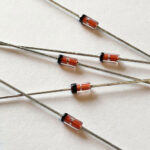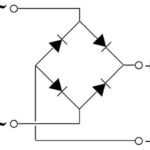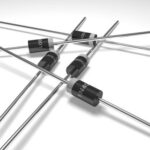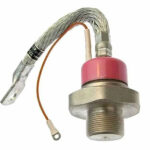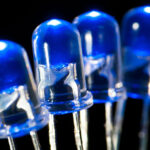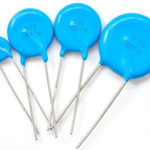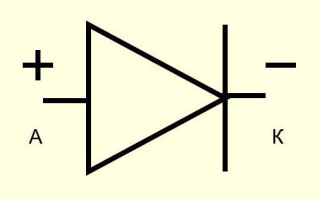The semiconductor diode is widely used in electrical engineering and electronics. With its low cost and good power-to-size ratio, it quickly replaced vacuum devices of a similar purpose.
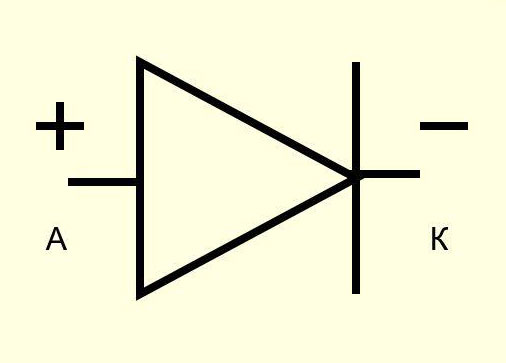
Content
The device and principle of operation of a semiconductor diode
A semiconductor diode consists of two regions (layers) made of a semiconductor (silicon, germanium, etc.). One region has an excess of free electrons (n-semiconductor), the other has a deficiency (p-semiconductor) - this is achieved by doping the base material. There is a small zone between them, in which an excess of free electrons from the n-site "closes" holes from the p-site (recombination occurs due to diffusion), and there are no free charge carriers in this region. When a forward voltage is applied, the recombination region is small, its resistance is small, and the diode conducts current in this direction. With reverse voltage, the carrier-free zone will increase, the resistance of the diode will increase. No current will flow in this direction.
Types, classification and graphic designation on electrical diagrams
In the general case, the diode in the diagram is indicated as a stylized arrow indicating the direction of current. The conditional graphic image (UGO) of the device contains two conclusions - anode and cathode, which in direct connection are connected to the plus of the electrical circuit and to the minus, respectively.

There are a large number of varieties of this bipolar semiconductor device, which, depending on the purpose, may have slightly different UGOs.
Zener diodes (Zener diodes)

A zener diode is a semiconductor deviceoperating at reverse voltage in the zone of avalanche breakdown. In this region, the Zener diode voltage is stable over a wide range of current through the device. This property is used to stabilize the voltage across the load.
Stabistors
Zener diodes do a good job of stabilizing voltages from 2 V and above.Stabistors are used to get a constant voltage below this limit. Doping of the material from which these devices are made (silicon, selenium) achieves the greatest verticality of the direct branch of the characteristic. In this mode, the stabistors work, giving out an exemplary voltage in the range of 0.5 ... 2 V on the direct branch of the current-voltage characteristic at forward voltage.
Schottky diodes

The Schottky diode is built according to the semiconductor-metal scheme, and does not have a conventional junction. Due to this, two important properties were obtained:
- reduced forward voltage drop (about 0.2 V);
- increased operating frequencies due to a decrease in self-capacitance.
The disadvantages include increased values of reverse currents and reduced tolerance to the level of reverse voltage.
Varicaps

Each diode has an electrical capacitance. The plates of the capacitor are two space charges (p and n regions of semiconductors), and the barrier layer is the dielectric. When a reverse voltage is applied, this layer expands and the capacitance decreases. This property is inherent in all diodes, but for varicaps, the capacitance is normalized and known for given voltage limits. This makes it possible to use such devices as variable capacitors and apply to adjust or fine-tune circuits by supplying reverse voltage of various levels.
tunnel diodes

These devices have a deflection in the straight section of the characteristic, in which an increase in voltage causes a decrease in current. In this region, the differential resistance is negative.This property makes it possible to use tunnel diodes as weak signal amplifiers and generators at frequencies above 30 GHz.
Dinistors

Dinistor - diode thyristor - has a p-n-p-n structure and an S-shaped CVC, does not conduct current until the applied voltage reaches the threshold level. After that, it turns on and behaves like a normal diode until the current drops below the holding level. Dinistors are used in power electronics as keys.
Photodiodes

The photodiode is made in a package with visible light access to the crystal. When a p-n junction is irradiated, an emf arises in it. This allows you to use the photodiode as a current source (as part of solar panels) or as a light sensor.
LEDs

The main property of an LED is the ability to emit light when current passes through a p-n junction. This glow is not related to the intensity of heating, like an incandescent lamp, so the device is economical. Sometimes the direct glow of the transition is used, but more often it is used as an initiator of the ignition of the phosphor. This made it possible to obtain previously unattainable LED colors, such as blue and white.
Gunn Diodes
Although the Gunn diode has the usual conventional graphic designation, it is not a diode in the full sense. Because it does not have a p-n junction. This device consists of a gallium arsenide plate on a metal substrate.
Without going into the details of the processes: when an electric field of a certain magnitude is applied in the device, electrical oscillations occur, the period of which depends on the size of the semiconductor wafer (but within certain limits, the frequency can be adjusted by external elements).
Gunn diodes are used as oscillators at frequencies of 1 GHz and above. The advantage of the device is the high frequency stability, and the disadvantage is the small amplitude of electrical oscillations.
Magnetic diodes
Ordinary diodes are weakly affected by external magnetic fields. Magnetodiodes have a special design that increases sensitivity to this effect. They are made using p-i-n technology with an extended base. Under the action of a magnetic field, the resistance of the device in the forward direction increases, and this can be used to create non-contact switching elements, magnetic field converters, etc.
Laser diodes
The principle of operation of a laser diode is based on the property of an electron-hole pair during recombination under certain conditions to emit monochromatic and coherent visible radiation. The methods of creating these conditions are different, for the user it is only necessary to know the length of the wave emitted by the diode and its power.
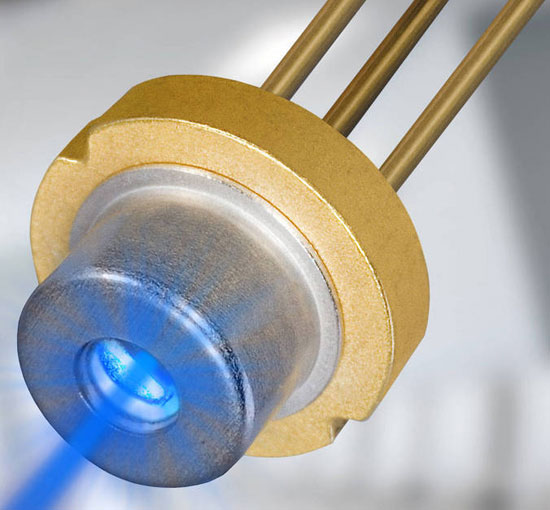
Avalanche diodes
These devices are used in the microwave. Under certain conditions, in the avalanche breakdown mode, a section with a negative differential resistance appears on the diode characteristic. This property of APD allows them to be used as generators operating at wavelengths up to the millimeter range. There it is possible to obtain a power of at least 1 watt. At lower frequencies, up to several kilowatts are removed from such diodes.
PIN diodes
These diodes are made using p-i-n technology. Between the doped layers of semiconductors is a layer of undoped material. For this reason, the rectifying properties of the diode are worsened (with reverse voltage, recombination is reduced due to the lack of direct contact between the p- and n-zones).But due to the spacing of the space charge regions, the parasitic capacitance becomes very small, in the closed state, signal leakage at high frequencies is practically excluded, and pin diodes can be used on RF and microwave as switching elements.
Main characteristics and parameters of diodes
The main characteristics of semiconductor diodes (except for highly specialized ones) include:
- the maximum allowable reverse voltage (constant and pulsed);
- boundary operating frequency;
- forward voltage drop;
- operating temperature range.
The rest of the important characteristics are best considered using the example of the I-V characteristics of the diode - this is more clear.
Volt-ampere characteristic of a semiconductor diode
The current-voltage characteristic of a semiconductor diode consists of a forward and reverse branch. They are located in I and III quadrants, since the direction of current and voltage through the diode always coincides. According to the current-voltage characteristic, you can determine some parameters, as well as clearly see what the characteristics of the device affect.
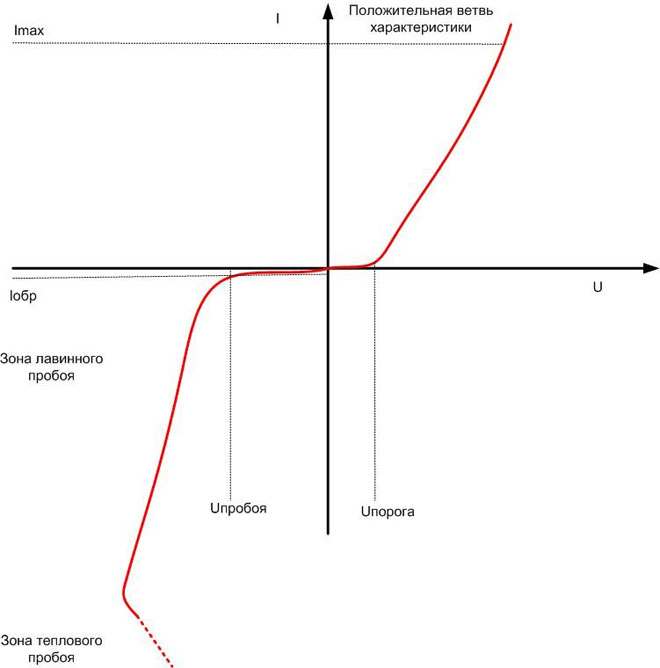
Conduction threshold voltage
If you apply a forward voltage to the diode and begin to increase it, then at the first moment nothing will happen - the current will not increase. But at a certain value, the diode will open and the current will increase according to the voltage. This voltage is called the conduction threshold voltage and is marked on the VAC as Uthreshold. It depends on the material from which the diode is made. For the most common semiconductors, this parameter is:
- silicon - 0.6-0.8 V;
- germanium - 0.2-0.3 V;
- gallium arsenide - 1.5 V.
The property of germanium semiconductor devices to open at low voltage is used when working in low-voltage circuits and in other situations.
Maximum current through the diode with direct connection
After the diode has opened, its current increases along with the increase in forward voltage. For an ideal diode, this graph goes to infinity. In practice, this parameter is limited by the ability of the semiconductor device to dissipate heat. When a certain limit is reached, the diode will overheat and fail. To avoid this, manufacturers indicate the highest allowable current (on the VAC - Imax). It can be roughly determined by the size of the diode and its package. In descending order:
- the greatest current is kept by devices in a metal sheath;
- plastic cases are designed for medium power;
- Diodes in glass envelopes are used in low-current circuits.
Metal appliances can be installed on radiators - this will increase the dissipation power.
Reverse leakage current
If you apply a reverse voltage to the diode, then an insensitive ammeter will show nothing. In fact, only an ideal diode does not pass any current. A real device will have a current, but it is very small, and is called the reverse leakage current (on the CVC - Iobr). It is tens of microamps or tenths of milliamps and much less than direct current. You can find it in the directory.
Breakdown voltage
At a certain value of the reverse voltage, a sharp increase in current occurs, called breakdown. It has a tunnel or avalanche character and is reversible. This mode is used to stabilize the voltage (avalanche) or to generate pulses (tunnel).With a further increase in voltage, the breakdown becomes thermal. This mode is irreversible and the diode fails.
Parasitic capacitance pn-junction
It has already been mentioned that the p-n junction has electrical capacity. And if this property is useful and used in varicaps, then in conventional diodes it can be harmful. Although capacity is units or tens of pF and at direct current or low frequencies is imperceptible, with increasing frequency its influence increases. A few picofarads at RF will create low enough resistance for spurious signal leakage, add to the existing capacitance and change the circuit parameters, and together with the inductance of the output or printed conductor form a spurious resonance circuit. Therefore, in the production of high-frequency devices, measures are taken to reduce the capacitance of the transition.
Diode marking
The easiest way to mark diodes in a metal case. In most cases, they are marked with the designation of the device and its pinout. Diodes in a plastic case are marked with a ring mark on the cathode side. But there is no guarantee that the manufacturer strictly observes this rule, so it is better to refer to the directory. Even better, ring the device with a multimeter.
Domestic low-power zener diodes and some other devices may have marks of two rings or dots of different colors on opposite sides of the case. To determine the type of such a diode and its pinout, you need to take a reference book or find an online marking identifier on the Internet.
Applications of diodes
Despite the simple device, semiconductor diodes are widely used in electronics:
- For straightening AC voltage. A classic of the genre - the p-n junction property is used to conduct current in one direction.
- diode detectors. Here, the nonlinearity of the I–V characteristic is used, which makes it possible to isolate harmonics from the signal, the necessary of which can be distinguished by filters.
- Two diodes, connected back-to-back, serve as a limiter for powerful signals that can overload subsequent input stages of sensitive radio receivers.
- Zener diodes can be included as spark-proof elements that do not allow high-voltage pulses to enter the circuits of sensors installed in hazardous areas.
- Diodes can serve as switching devices in high frequency circuits. They open with a constant voltage and pass (or do not pass) the RF signal.
- Parametric diodes serve as amplifiers of weak signals in the microwave range due to the presence of a section with negative resistance in the direct branch of the characteristic.
- Diodes are used to assemble mixers operating in transmitting or receiving equipment. They mix local oscillator signal with a high-frequency (or low-frequency) signal for further processing. It also uses the nonlinearity of the current-voltage characteristic.
- The non-linear characteristic allows the use of microwave diodes as frequency multipliers. When the signal passes through the multiplier diode, the higher harmonics are highlighted. Then they can be selected by filtering.
- Diodes are used as tuning elements for resonant circuits. In this case, the presence of a controlled capacitance at the p-n junction is used.
- Some types of diodes are used as generators in the microwave range. These are mainly tunnel diodes and devices with the Gunn effect.
This is only a brief description of the capabilities of dual-terminal semiconductor devices. With a deep study of the properties and characteristics with the help of diodes, it is possible to solve many problems assigned to the developers of electronic equipment.
Similar articles:
